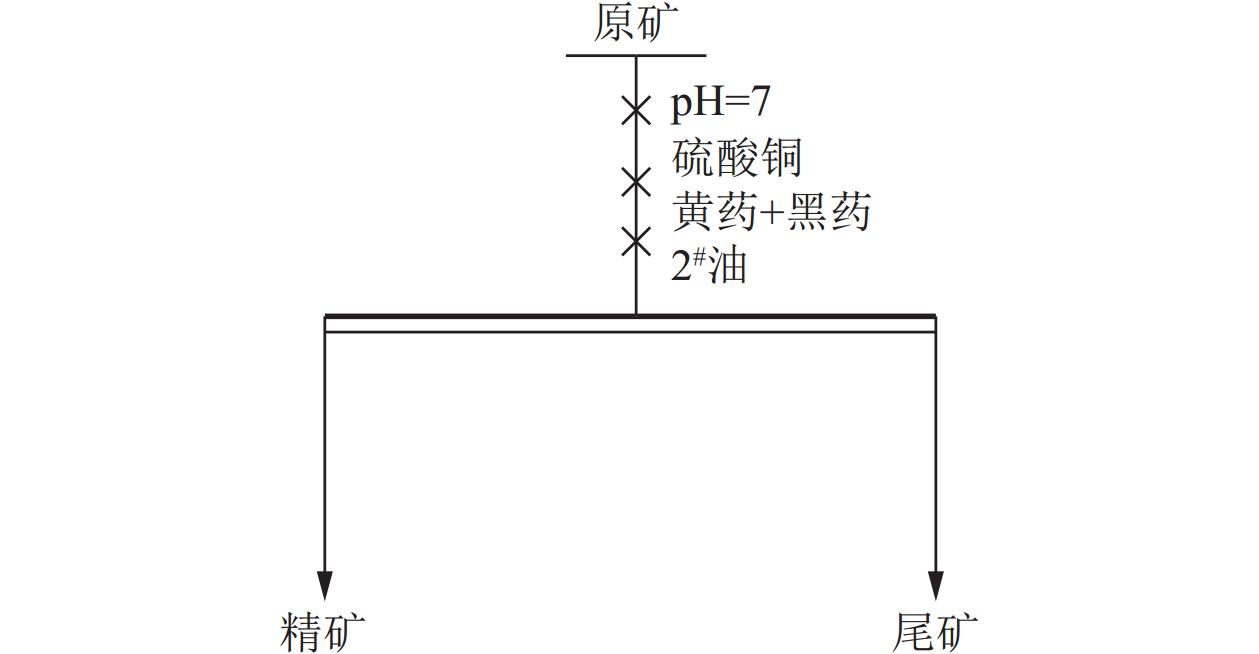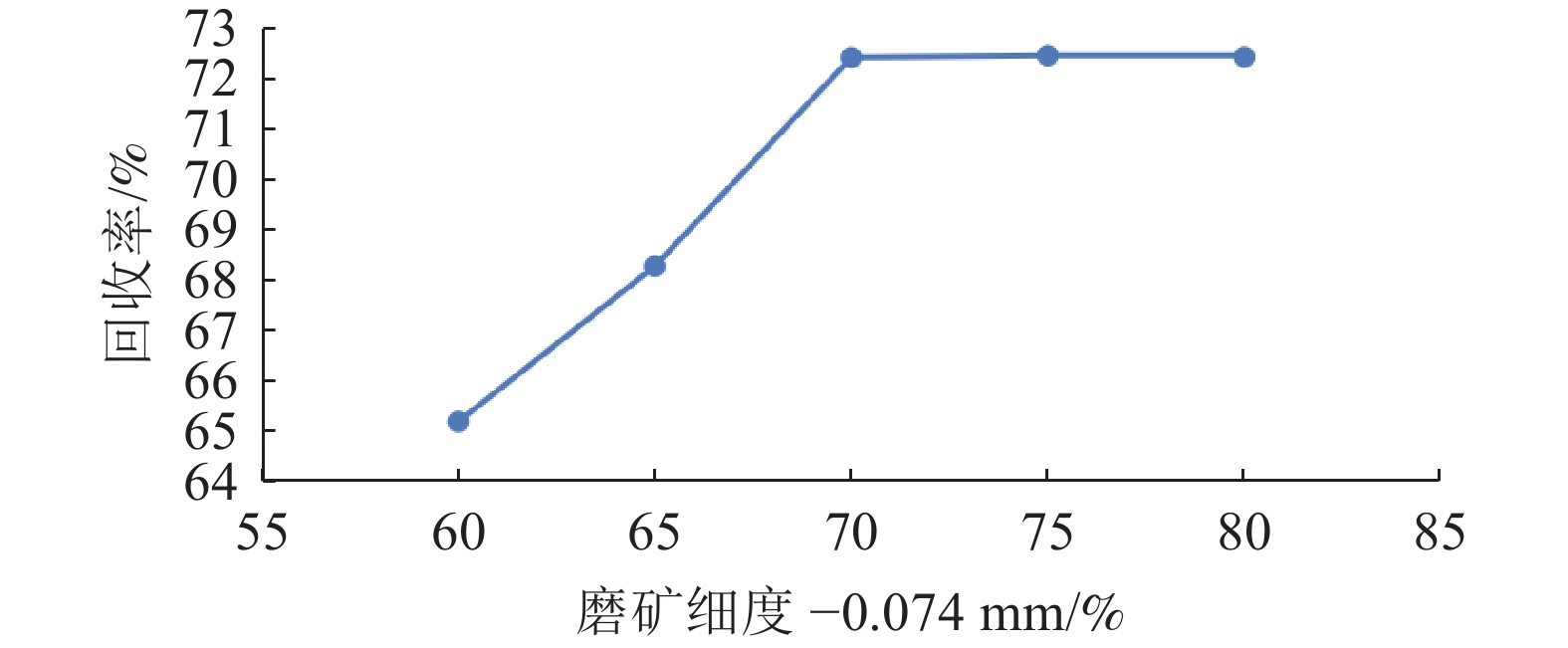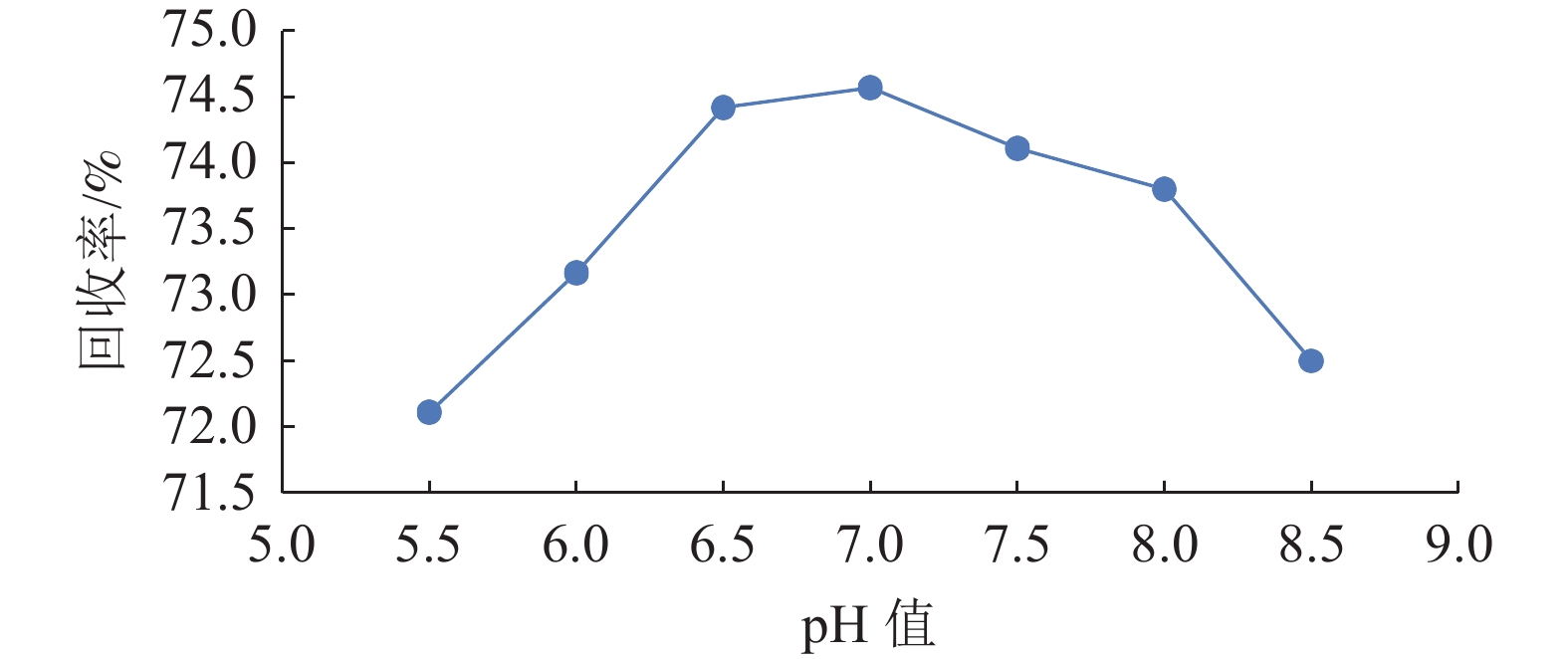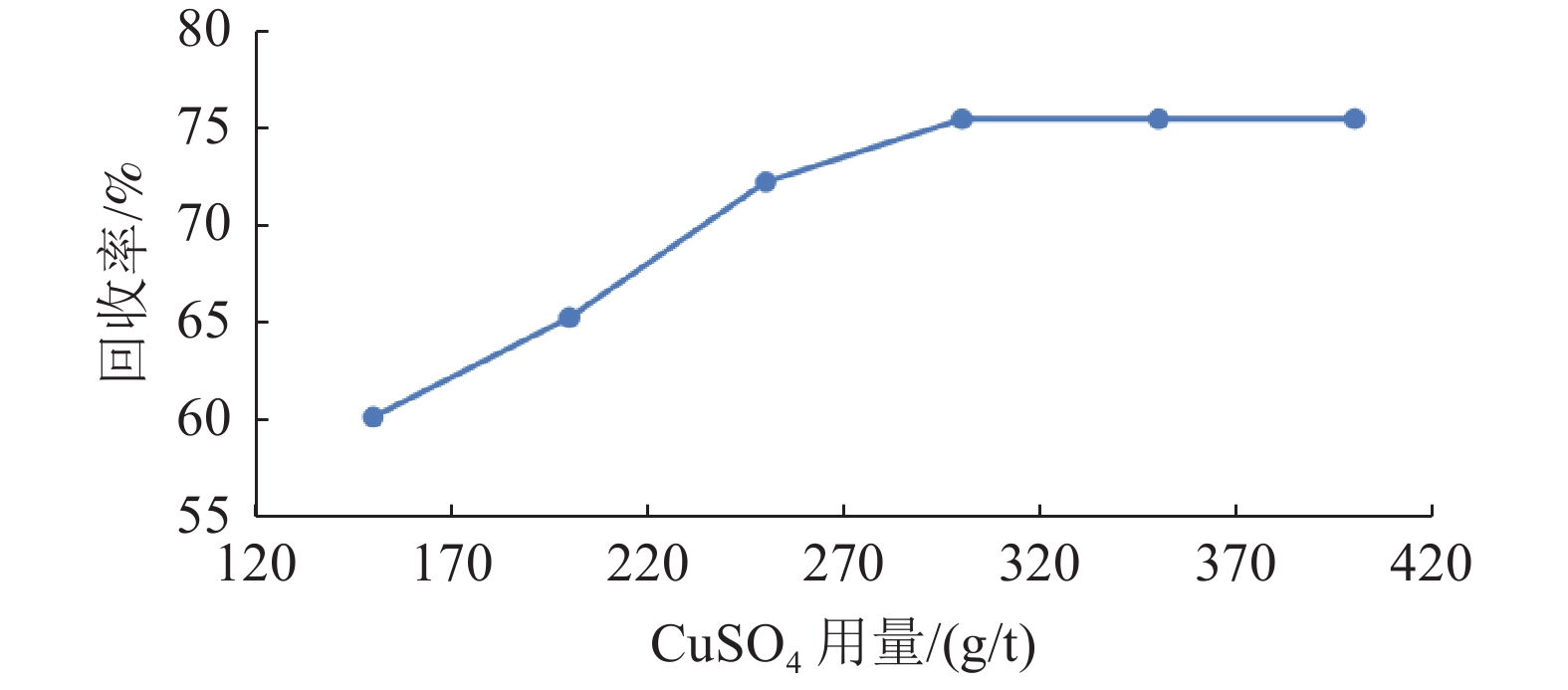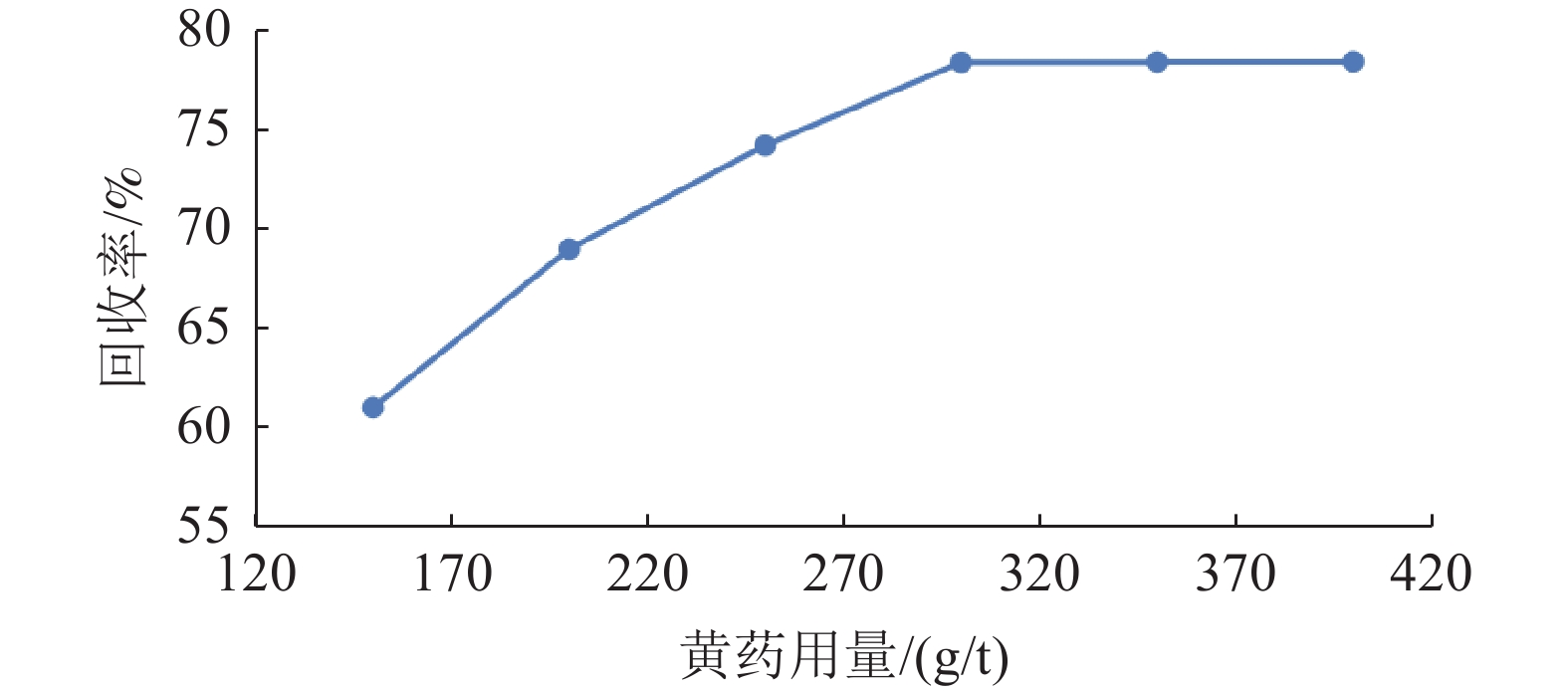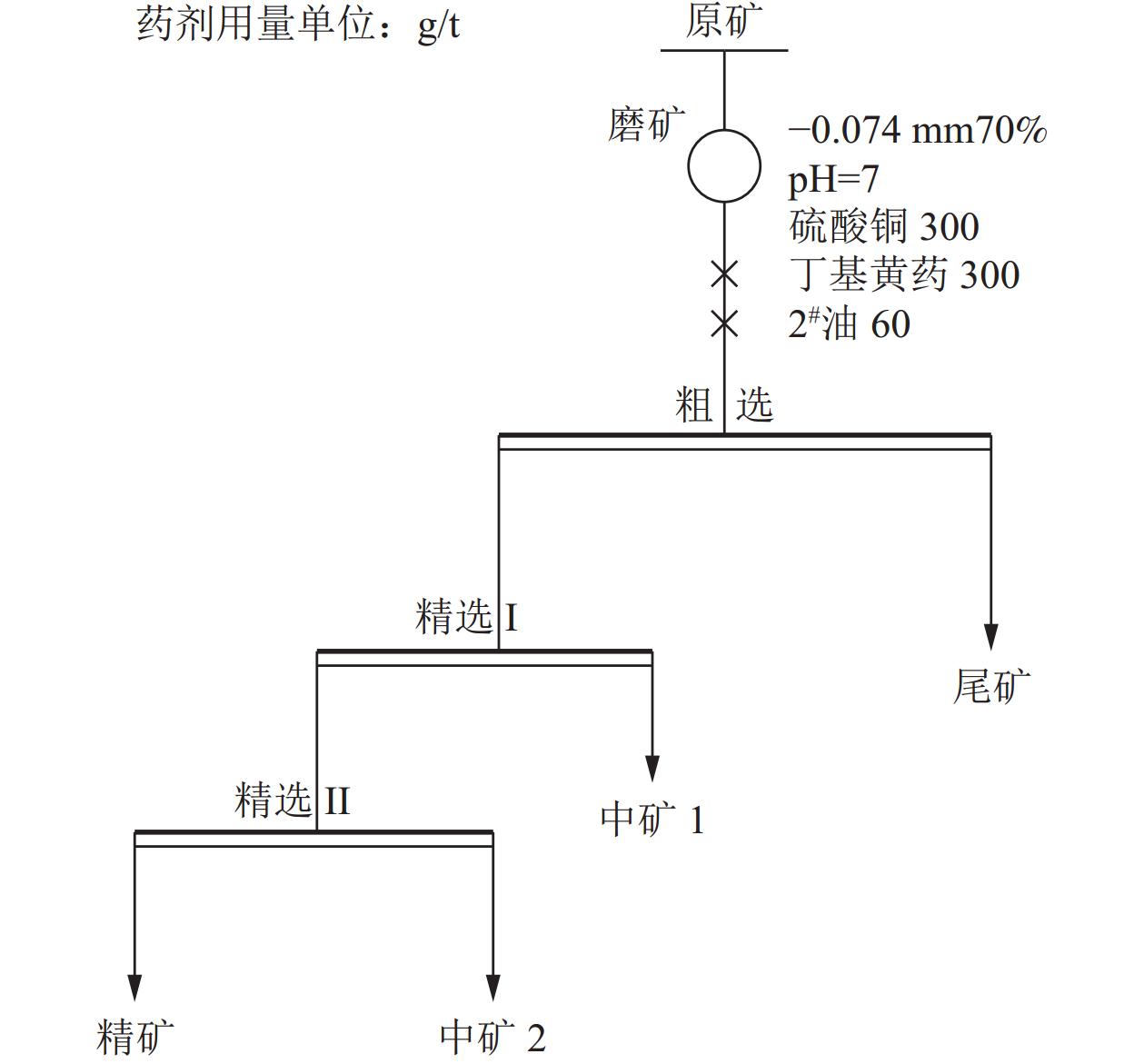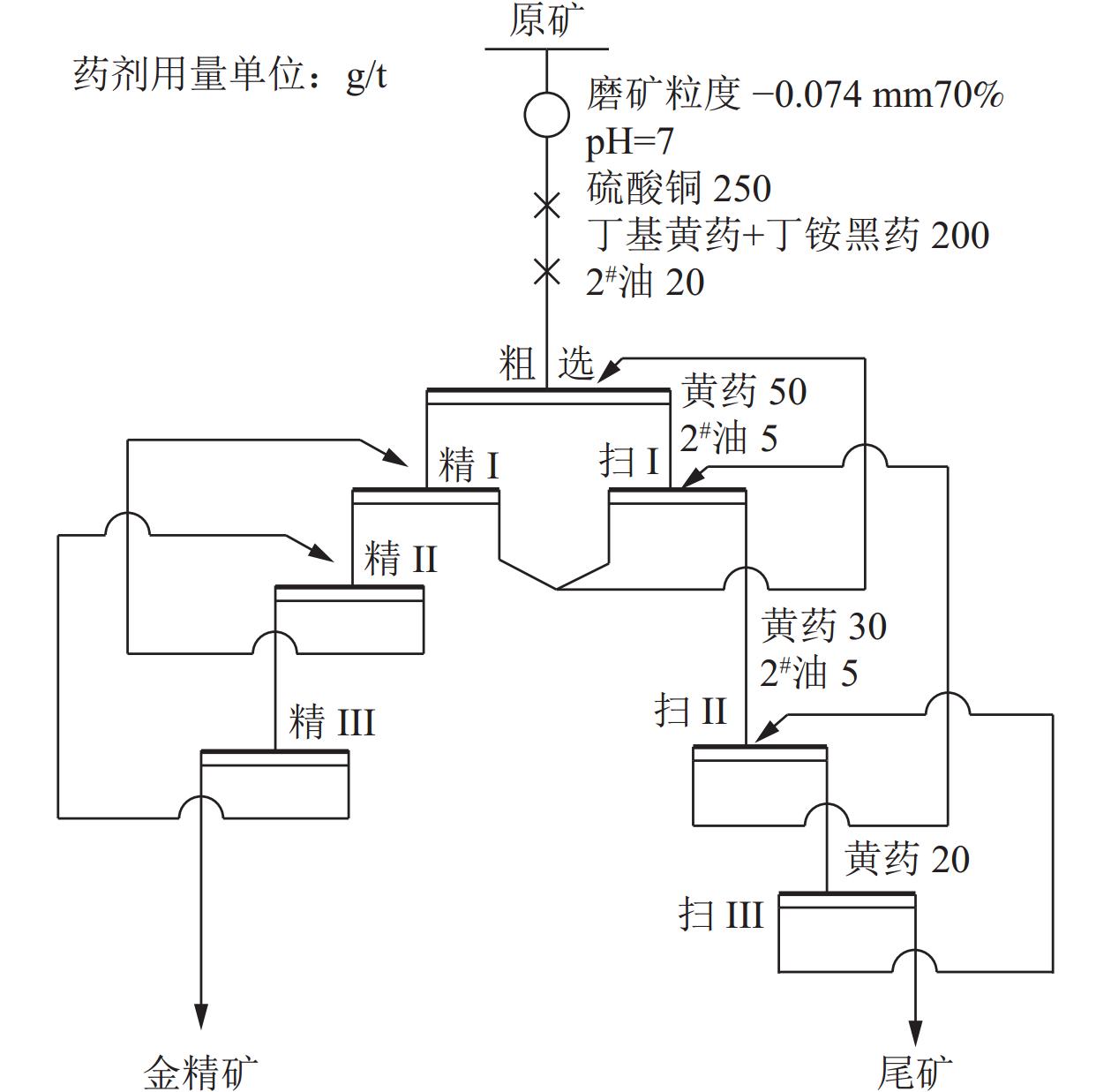Experimental Study on Mineral Processing of a Complex Refractory Gold Mine in Guizhou
-
摘要:
贵州某金矿原矿主要有回收利用价值的金矿物,原矿品位含金3.47 g/t,含硫5.12%,现场在常温条件下,用丁基黄药为捕收剂进行生产,金精矿的回收率为78.34%,金精矿品位为39.21 g/t,选矿指标不理想,造成资源浪费,严重影响企业的经济效益,针对这一情况,对该金矿进行实验研究。通过对矿浆进行加温,同时研究对该矿捕收效果良好的捕收剂丁铵黑药和丁基黄药按1:1使用,实验矿浆温度控制在50~55 ℃,与现场生产比较,金精矿浮选指标得到较大提高,实验室闭路实验得到实验结果为金精矿的品位44.86 g/t,金精矿金的回收率达到91.01%,为企业进行生产工艺流程改造提供技术依据。
Abstract:The gold mineral is the main one with recycling value in the raw ore of a gold mine in Guizhou. The gold grade of the raw ore is 3.47 g/t and the sulfur content is 5.12%. The recovery rate of the gold concentrate is 78.34% and the grade of the gold concentrate is 39.21 g/t when butyl xanthate is used as the collector for production at normal temperature. The beneficiation index is not ideal, resulting in a waste of resources. It seriously affects the economic benefit of the enterprise. In view of this situation, the experimental study is carried out on the gold mine. By heating the pulp and using the collector ammonium butyl aerofloat and butyl xanthate with good collection effect at the ratio of 1:1, the temperature of the test pulp is controlled at 50~55 ℃. Compared with the field production, the flotation index of the gold concentrate is greatly improved. The results of closed-circuit test in laboratory showed that the grade of gold concentrate was 44.86 g/t, and the recovery rate of gold concentrate was 91.01%, which provides technical basis for enterprises to reform the production process.
-
Keywords:
- Mineral processing engineering /
- Gold mine /
- Flotation test /
- Heating /
- Closed-circuit test
-
作为一种独特而珍贵的商品,黄金不仅承载着货币与商品的双重属性,其重要性在全球范围内日益凸显,成为各国经济体系中不可或缺的一环。同时黄金也是一种珍贵的金属材料,因黄金具有良好的机械加工性能及很好的导电性,而且黄金还具有强大的抗氧化和抗腐蚀能力等特性,其独特的物理和化学性质使得黄金及其合金在航空航天工业中被广泛应用,随着航空航天工业的发展,未来对黄金的需求量将越来越大。随着金矿资源的不断开发,优质易选金矿资源越来匮乏,而矿产是不可再生资源,因此,对复杂难选金矿的回收利用的研究将成为必然趋势[1-2]。
金矿物的主要处理方法:1.当金矿物以自然颗粒金为主,且粒度粗时用重选法比如尼尔森重选;2.当金矿石硫化物少,石英脉型含金矿石,金矿物嵌布粒度较细时采用浸出法,如氰化法;3.当金矿物以硫化矿物共生时采用浮选法回收游离的金矿物和硫化矿物。针对贵州某金矿现场生产部分金矿物可浮性差,金精矿金回收率低的情况,在矿物工艺学研究的基础上,对该矿进行选矿实验研究,探寻并确定适合该矿的选矿工艺流程,以提高矿石的选矿效率、降低生产成本,并最大化资源利用价值,为企业下一步进行选矿生产工艺流程改造提供可行的技术方案[3]。
1. 矿石性质
1.1 原矿化学分析
本文利用化学多元素分析和物相分析等方法,对其进行矿物工艺学研究[4-5],原矿分析结果见表1。由表1可知,试样金品位3.47 g/t,金是矿物中具有回收价值的唯一元素。
表 1 原矿化学成分分析结果/%Table 1. Analysis results of chemical composition of raw oresAu* Pb Zn S CaO Ag* SiO2 Al Mg 其他 3.47 0.08 0.12 5.12 7.18 6.12 37.23 18.42 11.38 20.18 *单位为g/t。 1.2 物相分析
矿物中金的赋存状态和硫物相分析结果见表2和表3。由表2可知,金矿物在矿石中72.16%金元素与黄铁矿共生,与硅矿物等多种矿物共生的为23.66%,还有少量的单体金[6-7],由表3结果可知,硫矿物主要是以黄铁矿,硫酸盐和自然硫较少。
表 2 矿石金矿物的物相分析结果Table 2. Phase analysis results of gold minerals名 称 黄铁矿 硅矿物 自然金 总 金 Au/(g/t) 2.63 0.82 0.02 3.47 分布率/% 72.16 23.66 4.18 100.00 表 3 矿石硫矿物的物相分析结果Table 3. Phase analysis results of sulfur minerals名 称 硫化物 硫酸盐 自然硫 总 硫 S/% 4.87 0.23 0.02 5.12 分布率/% 95.17 4.45 0.38 100.00 2. 实验结果与讨论
2.1 条件实验
通过对原矿的矿物组成分析结果可知,该金矿具有利用价值的主要矿物为金矿物,进行磨矿细度、矿浆pH值、硫酸铜用量、捕收剂用量实验,实验流程见图1。
2.1.1 磨矿细度实验
磨矿细度决定了有用矿物的单体解离度,直接影响浮选效果[8],在选矿中,金属矿物只有单体充分解离才能更好的回收,合理的磨矿粒度是良好浮选指标的关键,同时也是控制生产成本有效措施,因此选择合理的磨矿粒度对生产具有重大意义。在捕收剂用量为250 g/t,pH=7,硫酸铜用量为250 g/t,其他浮选条件不变的情况下对该矿进行磨矿粒度实验,实验结果见图2。
由图2可知,金的回收率随着增加磨矿细度增加而提高,金的回收率当磨矿粒度-0.074 mm 70%时,实验结果表明 再提高磨矿细度则金的回收率几乎没有变化,因此选择为-0.074 mm 70%作为后续实验的磨矿粒度。
2.1.2 矿浆pH值
作为金矿物浮选指标的关键因素之一的pH值,其值的大小将影响金矿物的浮选效果,在磨矿细度-0.074 mm 70%,捕收剂用量 250 g/t,硫酸铜用量 250 g/t,对在不同pH值进行浮选实验,pH值是用硫酸和石灰调节,实验结果见图3。
由图3可知,在pH值6.5~7.5金的回收率均比较稳定,pH>7.5时,金精矿的回收率开始下降,所以矿浆pH=7较为适合。
2.1.3 硫酸铜用量实验
活化剂是通过改善矿物表面疏水性,提高矿物的可浮性,硫酸铜是金矿物有效的活化剂,在磨矿细度 -0.074 mm 70%,捕收剂用量为250 g/t,pH=7 的情况下进行硫酸铜用量实验,结果见图4。
由图4可知,硫酸铜用量越大金精矿回收率越高,当硫酸铜的用量达到300 g/t时,金属的回收率几乎不再随硫酸铜用量变化而变化,因此,本实验硫酸铜的用量在300 g/t即可。
2.1.4 捕收剂用量实验
根据前人的研究结果及前期的探索性实验可知,实验选用丁基黄药+丁铵黑药作为捕收剂,其中丁基黄药+丁铵黑药按1∶1比例添加,比单一使用丁基黄药和丁铵黑药捕收效果更好[9-10],因此实验用丁基黄药+丁铵黑药按1∶1比例配制作为捕收剂。在磨矿细度 -0.074 mm 70%,硫酸铜用量在300 g/t,pH=7,捕收剂为变量的情况下,对捕收剂的用量与金精矿的回收率进行了实验,结果见图5。
由图5可知,捕收剂用量越大金精矿金金属的回收率越高,当捕收剂用量达到300 g/t时,继续加大捕收剂用量金的回收率没有明显改变,因此黄药用量在300 g/t较为适合。
2.2 开路实验
2.2.1 常温下开路实验
通过对条件实验的结果进行分析,以及对实验指标的综合比较,确定按图6的工艺流程进行开路实验,试剂条件见图6,实验结果见表4。
表 4 常温下开路实验结果Table 4. Open-circuit test results at normal temperature产 品 产率/% 品位/(g/t) 回收率/% 金精矿 5.37 42.11 65.19 中矿1 6.09 3.17 5.56 中矿2 3.23 10.18 9.47 尾 矿 85.31 0.80 19.78 给 矿 100.00 3.47 100.00 由表4结果可知,金精矿的回收率为65.19%,金精矿品位42.11 g/t,浮选指标不理想。因此为了寻找该金矿有效的浮选方法,对该矿进行了加温开路实验。
2.2.2 加温条件下的开路实验
由表4结果可知,在常温条件下金的开路实验指标不理想,根据提高矿浆温度可以提高矿物的可浮性原理[11],在加温条件下按图6进行了开路实验,通过探索实验,矿浆温度在50~55 ℃适宜,实验结果见表5。
表 5 加温下的开路浮选实验结果Table 5. Open-circuit flotation test results at elevated temperature产 品 产率/% 品位/(g/t) 回收率/% 金精矿 6.05 43.13 75.21 中矿1 4.78 3.88 5.35 中矿2 3.29 11.12 10.53 尾 矿 85.88 0.36 8.91 给 矿 100.00 3.47 100.00 由表5可知,金精矿回收率为75.21%,精矿品位含金为43.13 g/t,因此在加温条件下该金矿物的可浮性得到明显改善,浮选指标得到较大提高,随后在闭路实验中进一步验证具体浮选指标。
2.3 闭路实验
闭路实验是为了更好的考查浮选时中矿循环矿泥对浮选指标的影响,以及中矿中金属在精矿和尾矿的分布是否合理,也是确定精矿回收率的有效方法。由于在加温条件下进行开路实验取得较好的选矿指标,在优化开路实验条件下进行了实验室闭路实验,在实验中矿浆温度控制在50~55 ℃,闭路实验流程见图7,闭路实验结果见表6。
表 6 闭路实验结果Table 6. Closed-circuit test results产 品 产率/% 品位/(g/t) 回收率/% 金精矿 7.04 44.86 91.01 尾 矿 92.96 0.33 8.99 给 矿 100.00 3.47 100.00 由表6结果可知,在闭路实验中中矿的金金属得到合理的分配到金精矿和尾矿中,金精矿的回收率达到91.01%,金精矿品位为44.86 g/t,金精矿回收率得到较大幅度的提高,证明加温浮选能有效提高该金矿物的回收率。
3. 结 论
(1)该金矿原矿金含量为3.47 g/t,金矿物除了与黄铁矿共生外,部分金矿物与其他多种矿物共生关系密切,造成部分金矿物可浮性较差,现场生产金精矿的回收率为78.34%,金精矿品位39.21 g/t,属于复杂难选金矿物。
(2)由于该矿部分矿物的可浮性较差,在常温和用丁基黄药条件下浮选效果较差,在开路实验中金精矿的回收率仅为65.19%,精矿品位42.11 g/t。在常温和用丁基黄药开路实验的浮选条件下进行加温和用丁铵黑药和黄药按1∶1进行开路实验,温度控制在50~55 ℃,开路实验结果为金精矿的回收率为75.21%,金精矿品位43.13 g/t,在加温条件下浮选金精矿的回收率得到较大提高。
(3)将该金矿在矿浆进行加温,矿浆温度控制在50~55 ℃,同时在捕收剂以丁铵黑药和黄药按1∶1配比的条件下进行闭路实验,浮选指标结果得到较大提高。在该条件下进行的闭路实验可得该金精矿含金44.86 g/t,回收率为91.01%,为企业进行工艺流程改造提供了可行的技术方案。
-
表 1 原矿化学成分分析结果/%
Table 1 Analysis results of chemical composition of raw ores
Au* Pb Zn S CaO Ag* SiO2 Al Mg 其他 3.47 0.08 0.12 5.12 7.18 6.12 37.23 18.42 11.38 20.18 *单位为g/t。 表 2 矿石金矿物的物相分析结果
Table 2 Phase analysis results of gold minerals
名 称 黄铁矿 硅矿物 自然金 总 金 Au/(g/t) 2.63 0.82 0.02 3.47 分布率/% 72.16 23.66 4.18 100.00 表 3 矿石硫矿物的物相分析结果
Table 3 Phase analysis results of sulfur minerals
名 称 硫化物 硫酸盐 自然硫 总 硫 S/% 4.87 0.23 0.02 5.12 分布率/% 95.17 4.45 0.38 100.00 表 4 常温下开路实验结果
Table 4 Open-circuit test results at normal temperature
产 品 产率/% 品位/(g/t) 回收率/% 金精矿 5.37 42.11 65.19 中矿1 6.09 3.17 5.56 中矿2 3.23 10.18 9.47 尾 矿 85.31 0.80 19.78 给 矿 100.00 3.47 100.00 表 5 加温下的开路浮选实验结果
Table 5 Open-circuit flotation test results at elevated temperature
产 品 产率/% 品位/(g/t) 回收率/% 金精矿 6.05 43.13 75.21 中矿1 4.78 3.88 5.35 中矿2 3.29 11.12 10.53 尾 矿 85.88 0.36 8.91 给 矿 100.00 3.47 100.00 表 6 闭路实验结果
Table 6 Closed-circuit test results
产 品 产率/% 品位/(g/t) 回收率/% 金精矿 7.04 44.86 91.01 尾 矿 92.96 0.33 8.99 给 矿 100.00 3.47 100.00 -
[1] 张永涛. 中国矿产资源开发及矿产品供需关系形势分析[J]. 中国矿业, 2009, 18(2):8-11.ZHANG Y T. The development status and supply-demand situation analysis of China’s gold resources[J]. China Mining Magazine, 2009, 18(2):8-11. doi: 10.3969/j.issn.1004-4051.2009.02.003 ZHANG Y T. The development status and supply-demand situation analysis of China’s gold resources[J]. China Mining Magazine, 2009, 18(2):8-11. doi: 10.3969/j.issn.1004-4051.2009.02.003
[2] 邱曼, 黄学雄, 毛益林, 等. 我国金矿资源概况及选冶技术研究进展[J]. 矿产综合利用, 2023(3):106-115.QIU M, HUANG X X, MAO Y L, et al. General situation of gold resources and research progress of mineral processing and hydrometallurgy technology in China[J]. Multipurpose Utilization of Mineral Resources, 2023(3):106-115. doi: 10.3969/j.issn.1000-6532.2023.02.019 QIU M, HUANG X X, MAO Y L, et al. General situation of gold resources and research progress of mineral processing and hydrometallurgy technology in China[J]. Multipurpose Utilization of Mineral Resources, 2023(3):106-115. doi: 10.3969/j.issn.1000-6532.2023.02.019
[3] 赵福财, 栾东武, 丁雨坡, 等. 甘肃某含砷锑难处理金矿选矿试验研究[J]. 黄金, 2024(6): 45-49.ZHAO F C, LUAN D W , DING Y P, et al. Experiment study on dressing of a refractory ore containing arsenic and antimony in Gansu[J]. Gold, 2024(6): 45-49. ZHAO F C, LUAN D W , DING Y P, et al. Experiment study on dressing of a refractory ore containing arsenic and antimony in Gansu[J]. Gold, 2024(6): 45-49.
[4] 陈艳波, 李光胜, 朱幸福, 等. 甘肃某含砷高硫金矿浮选实验[J]. 矿产综合利用, 2024, 45(3):206-210.CHEN Y B, LI G S, ZHU X F, et al. Flotation of an arsenic bearing high sulfur gold mine in Gansu province[J]. Multipurpose Utilization of Mineral Resources, 2024, 45(3):206-210. doi: 10.3969/j.issn.1000-6532.2024.03.032 CHEN Y B, LI G S, ZHU X F, et al. Flotation of an arsenic bearing high sulfur gold mine in Gansu province[J]. Multipurpose Utilization of Mineral Resources, 2024, 45(3):206-210. doi: 10.3969/j.issn.1000-6532.2024.03.032
[5] 董再蒸, 高鹏, 张淑敏, 等. 甘肃早子沟金矿石工艺矿物学研究[M]. 东北大学学报(自然科学版)2017(5): 712-715.DONG Z Z, GAO P, ZHANG S M, et al. Process mineralogy of gold ore in Zaozigou gold mine[M]. Gansu Province Journal of Northeastern University (Natural Science), 2017(5): 712-715. DONG Z Z, GAO P, ZHANG S M, et al. Process mineralogy of gold ore in Zaozigou gold mine[M]. Gansu Province Journal of Northeastern University (Natural Science), 2017(5): 712-715.
[6] 李磊, 彭俊, 肖仪武, 等. 影响非洲某金矿选冶回收的矿物学因素[J]. 矿产综合利用, 2023(6):202-206.LI L, PENG J, XIAO Y W, et al. Mineralogical factors affecting beneficiation-metallurgy of a gold deposit in Africa[J]. Multipurpose Utilization of Mineral Resources, 2023(6):202-206. doi: 10.3969/j.issn.1000-6532.2023.06.031 LI L, PENG J, XIAO Y W, et al. Mineralogical factors affecting beneficiation-metallurgy of a gold deposit in Africa[J]. Multipurpose Utilization of Mineral Resources, 2023(6):202-206. doi: 10.3969/j.issn.1000-6532.2023.06.031
[7] 皇甫明柱, 盛娜, 邓久帅. 安徽某高硫金矿选矿试验[J]. 现代矿业, 2016, 32(09):82-85.HUANGFU M Z, SHENG N, DENG J S, et al. Beneficiation experiment on a high sulfur gold ore from Anhui[J]. Modern Mining, 2016, 32(09):82-85. doi: 10.3969/j.issn.1674-6082.2016.09.023 HUANGFU M Z, SHENG N, DENG J S, et al. Beneficiation experiment on a high sulfur gold ore from Anhui[J]. Modern Mining, 2016, 32(09):82-85. doi: 10.3969/j.issn.1674-6082.2016.09.023
[8] 闫军宁. 提升贵州水银洞金矿浮选工艺指标生产实践[J]. 矿产综合利用, 2022(1):164-167.YAN J N. Production practice to improve the flotation process index of Shuiyindong gold mine in Guizhou Province[J]. Multipurpose Utilization of Mineral Resources, 2022(1):164-167. doi: 10.3969/j.issn.1000-6532.2022.01.022 YAN J N. Production practice to improve the flotation process index of Shuiyindong gold mine in Guizhou Province[J]. Multipurpose Utilization of Mineral Resources, 2022(1):164-167. doi: 10.3969/j.issn.1000-6532.2022.01.022
[9] 姚金, 薛季玮, 印万忠, 等. 贵州某含硫微细粒浸染型金矿石选矿试验[J]. 金属矿山, 2016(02):77-81.YAO J, XUE J W, YIN W Z, et al. Experiments of a micro-disseminated gold ore contains sulfur in Guizhou[J]. Metal Mine, 2016(02):77-81. doi: 10.3969/j.issn.1001-1250.2016.02.016 YAO J, XUE J W, YIN W Z, et al. Experiments of a micro-disseminated gold ore contains sulfur in Guizhou[J]. Metal Mine, 2016(02):77-81. doi: 10.3969/j.issn.1001-1250.2016.02.016
[10] 袁凤香. 四川某金矿选矿工艺试验研究[J]. 现代矿业, 2023, 39(11):121-123.YUAN F X. Experimental study on beneficiation process of a gold mine in Sichuan[J]. Modern Mining, 2023, 39(11):121-123. doi: 10.3969/j.issn.1674-6082.2023.11.029 YUAN F X. Experimental study on beneficiation process of a gold mine in Sichuan[J]. Modern Mining, 2023, 39(11):121-123. doi: 10.3969/j.issn.1674-6082.2023.11.029
[11] 杨佐怀, 董越, 郭俊杰, 等. 新疆某金矿选冶联合工艺研究[J]. 矿产综合利用, 2022(3):121-125.YANG Z H, DONG Y, GUO J J, et al. Beneficiation and metallurgical process study for a gold mine in Xinjiang[J]. Multipurpose Utilization of Mineral Resources, 2022(3):121-125. doi: 10.3969/j.issn.1000-6532.2022.03.021 YANG Z H, DONG Y, GUO J J, et al. Beneficiation and metallurgical process study for a gold mine in Xinjiang[J]. Multipurpose Utilization of Mineral Resources, 2022(3):121-125. doi: 10.3969/j.issn.1000-6532.2022.03.021



 下载:
下载:
